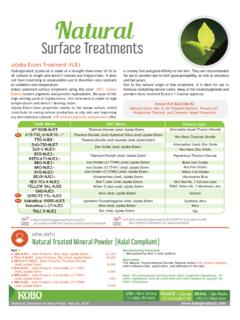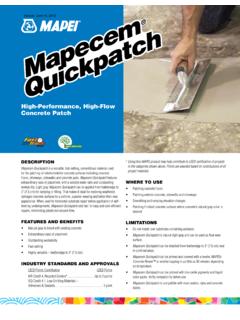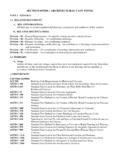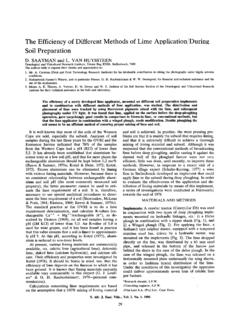Transcription of ORTHOPAEDIC IMPLANTS (1) - Danco
1 Metal surfacinganodizingTITANIUM ANODIZINGThe Finish of Choice forOrthopaedic anodizing provides products with improved propertiescompared to those in a raw or unfinished state. Testdata validates numerous mechanical benefits, and observationwith a 10x eyepiece reveals the leveling effects of theprocess. Scars from machining and/or deburring are leveled into a continuous, smoother, gray-colored surface. The twomost common types of treatment are Type 2 anodizing andcolor II AnodizingAnodic treatment of titanium and its alloys (Type 2anodization) is typically performed in accordance with SAEI nternational s AMS 2488 Standard. The process is coveredunder an Aerospace Material Specification, as it was firstdeveloped for treatment of parts associated with the air andspace industries. Advantages associated with the Type 2titanium anodizing process include increased lubricity,antigalling, and increased fatigue strength.
2 As these advantageshave become increasingly apparent, the popularity andacceptance of this coating have grown considerably withinthe medical device industry, especially in terms of itsapplicability to the finishing of orthopedic IMPLANTS . Theanodization process accelerates the formation of an oxidecoating under controlled conditions to provide the desiredresult. Since the coating is biocompatible as well as nontoxic,the process lends itself to achieving drastic improvementin implant coating is created using various electrolytes, whereby thedevices are made positive (anodic), with a correspondingnegative (cathodic) terminal attached to a powersupply. As the process creates a penetrating coating, there isno measurable dimensional change when measured with amicrometer accurate to inch ( m). Qualityinspection (100% visual) is performed on completed factors that impact the end result include:cleaning and surface preparation; solution limits andcontrol; voltage limits and control; temperature limits andcontrol.
3 And post-anodizing treatment and of Type 2 produces anti-galling and wear resistant surface properties increases fatigue strength up to 20% due to the homogeneous surface treatment improves surface finish by 50% or greater without special vibratory or burnishing processes increased lubricity enhances mateability of moving parts,thus reducing erosion/abrasion, and reduces fretting high strength-to-weight ratio improves fatigue properties,yields excellent corrosion resistance coating is continuous, smooth and adherent, without flaking in highly stressed areas coating can be welded to, or over characteristically gray color of anodized titanium is easilydistinguishable from stainless steelApplicationsProducts for which titanium anodization is applicable rangefrom orthopedic and dental IMPLANTS , to undersea mateableconnectors, to aerospace components. Within theorthopaedic industry, products for which this type of treatmentis often applied include bone plates and screws, intramedullarynails and rods, spine cages, and other hardware commonlyassociated with trauma or spinal AnodizingThe second type of titanium anodizing treatment commonlyapplied within the device industry is color anodizing.
4 UnlikeType 2 anodizing, there are no governmental or regulatorybodies that have issued specifications relative to coloranodizing. Consequently, numerous proprietary processesabound that might only be referenced on customer prints asituation that frequently causes confusion for OEMs whenTitanium screws: anodized screw on leftALUMINUM AND TITANIUM FINISHING AND ANODIZING FOR PROTECTION, WEAR AND APPEARANCET here are other factors which may affect the application of anodized coatings or the base product after anodizing. Please consult with our technical support staff. 2003 DANCO44 La Porte , CA 91006626-445-3303 Fax: 626-445-31351750 Monticello CourtOntario, CA 91761909-923-0562 Fax: 909-923-5325401 W. RowlandSanta Ana, CA 92707714-557-2411 Fax: 714-557-04082450 Deelyn , IN 46580574-269-5900 Fax: 574-269-5966 Visit our web site: w to describe a process. For example, Danco uses proprietary documentation to detail its color anodizing process, in conjunction with a color standard that has been mutually agreed upon with a customer prior to is one member of a family of metals (that includes niobium and tantalum) that color anodizes because it is reactive"; , it reacts when excited by heat or electricity in an electrolyte by creating a thin oxide layer at the surface.
5 The oxide layer presents itself in color due to an interference phenomenon. This layer is a very thin, transparent coating that derives its color when white light reflects off the base metallic surface, only to be interfered with" within the coating. Some frequencies of light waves escape and recombine with surface light to be either reinforced or cancelled out producing the color we Color"As the coating thickness increases, different frequencies escape, creating a variety of colors. The colors produced appear in up to five repeating orders. Not all the colors of the light spectrum are produced. Neither true red" nor forest green" are generated. Color anodized coatings are super thin (in the range of 200 to 3000 Angstroms) and, although they are harder than the titanium parts themselves, they do not exhibit excellent abrasion resistance characteristics because of the thinness of the oxide voltage being applied to the part(s) through an electrolytic bath controls the color.
6 The coating may be created using various electrolytes, where the parts are made positive (anodic), with a corresponding negative (cathodic) terminal attached to a power supply. Processes are available that can selectively" anodize surfaces to meet a particular customer s Standards"Understandably, it is important to a customer that every part be the same color within a lot, regardless of whether that lot quantity is 5, 50 or 5,000. Uniformity of color is achieved by developing process parameters and implementing controls that permit strict adherence to an established color standard. It isimportant to understand that the metal itself does not changecolor there are no dyes or pigments as are found in aluminumanodizing. Rather, the thin, transparent oxide layer generates the interference" colors. Because of the absence of dyes andpigments, anodized titanium IMPLANTS are both hypoallergenicand the medical device industry, products are color anodizedprimarily for cosmetic and/or identification purposes.
7 In theOperating Room, for example, the staff might desire tohave magenta, blue, gold, green and bronze colors" that canhelp visibly differentiate various lengths of screws that possessthe same summary, one may ask the "Why Anodize?"Advantages/Features of Titanium AnodizingType 2 Anodizing-up to 20% increase in fatigue strength- anti-galling/increased lubricity- b iocompatible- no dimensional change- improved surface finish- visual differentiation from stainless steel Color Anodizing- provides identification feature- cosmetically appealing- biocompatible- some increased lubricity- no dimensional change- variety of colors availableCombinations of Type 2 and color anodizing treatments can beapplied to the same component. By using masking and/orselective anodizing techniques, these surface treatments not onlyadd beneficial performance characteristics, but they also providea unique look while concurrently incorporating distinctiveidentification, orientation, or design considerations and features.

















